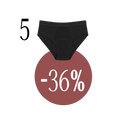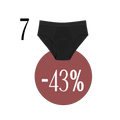How to calculate your menstrual cycle: complete guide and practical tips
Understanding and calculating your menstrual cycle is essential to better understand your body, anticipate your periods and monitor your hormonal health. However, many women do not know how to calculate it accurately. In this article, we guide you step by step to learn how to calculate your menstrual cycle and gain useful information for your well-being.
What is a menstrual cycle?
The menstrual cycle refers to the set of physiological changes that occur in the body of a woman of childbearing age to prepare for a possible pregnancy. It begins on the first day of her period and ends on the day before her next period.
Average duration of a cycle:
- An average cycle lasts 28 days , but it can vary from 21 to 35 days in some women.
- Irregular cycles are also common, especially at certain times in life such as puberty or premenopause.
Why is it important to know your menstrual cycle?
Calculating your menstrual cycle allows you to:
- Anticipating your period : Useful for planning events or preparing for travel.
- Identifying fertile periods : Essential for those who wish to conceive or avoid pregnancy.
- Detect irregularities : An abnormal cycle can reveal hormonal health problems.
- Understanding your body : Tracking your cycle helps you better manage premenstrual symptoms or hormonal fluctuations.
How to calculate your menstrual cycle?
1. Note the date of your period
The calculation begins by tracking your menstrual periods. Note:
- The first day of your period : It marks the start of a new cycle.
- Period duration : This information is useful for assessing your menstrual flow and your need for sanitary protection.
2. Count the total duration of the cycle
To find out the length of your cycle, count the number of days between the first day of your period and the day before your next period.
Example :
- If your period starts on January 1st and your next period starts on January 29th, your cycle is 28 days long.
3. Follow several cycles
To get a reliable average, it is recommended to follow your cycle over several months. You will be able to:
- Identify the regularity of your cycle.
- Identify variations and understand what causes them.
What are the different phases of the menstrual cycle?
The menstrual cycle is divided into four main phases:
- Menstrual phase
- Duration: 3 to 7 days.
- What happens: The endometrium (uterine lining) sheds and is released as bleeding.
- Common symptoms: Fatigue, abdominal pain, emotional sensitivity.
- Follicular phase
- Duration: From the first day of your period until ovulation.
- What happens: The ovaries begin preparing an egg under the influence of follicle-stimulating hormone (FSH).
- Common symptoms: Gradual increase in energy and focus.
- Ovulation
- Duration: 24 to 48 hours.
- What happens: A mature egg is released and can be fertilized.
- Common symptoms: Slightly elevated body temperature, clear, stringy cervical mucus, increased libido.
- Luteal phase
- Duration: 12 to 16 days after ovulation.
- What happens: The body produces progesterone to maintain a possible pregnancy. If the egg is not fertilized, hormone production decreases, leading to a period.
- Common symptoms: Bloating, tender breasts, irritability (premenstrual syndrome).
How to use a calendar to track your cycle?
Manual tracking using a calendar or journal can be a simple and effective way to understand your cycle. Here's how to do it:
- Mark the first day of your period each month.
- Indicate the duration of bleeding (eg 5 days).
- Add notes about your symptoms (pain, fatigue, mood changes).
Modern tools to track your cycle
With technological advances, there are applications and connected tools to simplify the monitoring of your cycle:
- Mobile apps : Clue, Flo, or Period Tracker are popular apps that allow you to record your data and receive reminders.
- Fitness trackers : Some devices like Ava track your body temperature and other parameters to detect ovulation.
What to do in case of irregular cycle?
A cycle is considered irregular if its length varies significantly from month to month. For example, a 28-day cycle followed by a 35-day cycle may indicate irregularity.
Common causes of irregular cycles:
- Stress : Stress can disrupt hormone production.
- Hormonal problems : Such as polycystic ovarian syndrome (PCOS) or hypothyroidism.
- Weight changes : Rapid weight loss or gain can affect the cycle.
- Contraception : Some hormonal methods can cause fluctuations.
When to see a doctor?
If your cycles are irregular for several months or if you experience unusual symptoms (heavy bleeding, severe pain), it is important to consult a healthcare professional.
How to calculate your fertile period?
The fertile window is the days when a woman is most likely to conceive. It is usually around ovulation, which occurs about 14 days before the start of her period .
Methods to calculate the fertile period:
- Calendar Method : Identify the days between days 10 and 17 of your cycle if your cycle is 28 days long.
- Basal temperature monitoring : Take your temperature every morning. A slight increase indicates ovulation.
- Observation of cervical mucus : During the fertile period, the mucus becomes transparent, stringy and slippery.
1. Can you have a regular cycle and not ovulate?
Yes, it is possible to have so-called "anovulatory" cycles, where no ovulation occurs, particularly at certain times of life (puberty, menopause).
2. Do hormonal contraceptives affect cycle calculation?
Yes, hormonal contraceptives usually suppress ovulation, making cycle calculation less relevant.
3. Can you calculate your cycle without having regular periods?
This can be more difficult, but tracking bodily symptoms (temperature, cervical mucus) can provide helpful clues.
Learning how to calculate your menstrual cycle is an enriching process that allows you to better understand your body, anticipate hormonal fluctuations and detect potential imbalances. Whether you use a calendar, a mobile application or body observations, tracking your cycle is a simple and powerful way to take care of yourself. Please feel free to share this article to help other women better control their menstrual health.




